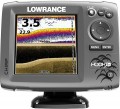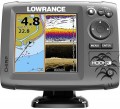Type
The type defines the general purpose of the device.
—
Echo sounder. Echo sounders are devices designed to study water bodies using sonar. The principle of operation of an echo sounder is similar to that of a radar, but it does not use radio waves, but ultrasound. The initial purpose of such devices is the creation of topographic maps of the bottom of a reservoir, the determination of its topography and depth in various places. However, in addition to this, the echo sounder can be used to detect fish, and with good quality of the device and correctly set settings, you can even determine the approximate size of potential prey.
—
Chartplotter. A chartplotter can be described as a dedicated GPS navigator designed for marine use and equipped with related additional features. Such functions include, at a minimum, working with sailing directions (detailed maps of water bodies, indicating depths, currents, etc.); in addition, support for meteorological services, additional equipment such as radars or specific navigation sensors, etc. can be provided. Note that the GPS receiver can be either built-in or external; see Chartplotter Specifications for details.
—
Sonar chart plotter. Models that combine the capabilities of both types described above in one device. Such devices are the most versatile, however, and cost accordingly.
— Sonar fl
...asher. A specific type of echo sounder, designed specifically for use in one place, without movement. Initially, such devices were generally developed for fishing from an ice hole in winter — although this is not limited to such fishing — flashers are also used in summer, including in open water when fishing from a boat. Such devices are by definition capable of displaying fish in real time (see "Functions"), however, instead of a traditional screen, a circular indicator is used, thanks to which the user can determine the direction of the detected object. And the features of this object (more precisely, the signal reflected from it) can be determined by the colour of the mark on the indicator: for example, a red mark corresponds to a strong signal, yellow to an average signal, green to a weak one. Another advantage of a flasher over a traditional fish finder is its high sensitivity, which allows you to follow even small baits. Thanks to all this, such devices are quite popular among anglers, however, they are not cheap.Digital data processing
The presence of a
digital data processing system (DSP) in the design of the echo sounder.
Digital processing allows you to separate the received signal into extraneous noise and useful data. Of course, such a division is not 100% reliable; however, the level of noise in the filtered signal is still significantly reduced, and the screen receives a maximum of useful information and a minimum of extraneous information. The disadvantage of this function is traditional: echo sounders with DSP are somewhat more expensive than usual ones.
Connection interfaces
—
Ethernet. This standard is also known as LAN or RJ-45. Its original purpose is the construction of general-purpose wired computer networks; however, Ethernet can also be used in special networks — including used by navigation equipment. Note that this interface is technically capable of providing a higher data transfer rate than NMEA, so it can be used for tasks that require the transfer of a large amount of data — for example, connecting to the Internet via a satellite module.
—
NMEA. Abbreviation for "National Marine Electronics Association", "National Marine Electronics Association". This interface is used to interconnect various "marine" electronics, mainly navigation — echo sounders, chartplotters, radars, VHF radios, gyrocompasses, sensors in engines, etc. Accordingly, its support allows you to connect the device with other specialized devices and sensors. Note that there are several versions of NMEA. The most popular at the moment is NMEA 0183, it is this standard that is supported by most special equipment. A more advanced version is NMEA 2000, which is not yet widely used. More information about the different versions and their compatibility can be found in special sources.
—
Output for external GPS antenna. This function can occur regardless of whether the device has a built-in GPS receiver (see above). If such a receiver is not available,
...then the ability to connect an external antenna (more precisely, a whole GPS module) is almost mandatory for devices with the chartplotter function (see "Type") — otherwise they will not be able to effectively perform their tasks. However, for models with their own receiver, an external antenna may come in handy — it is usually more sensitive than the internal one and allows you to more accurately determine the location of the device, especially in difficult conditions (atmospheric interference, navigation through narrow fjords, etc.). At the same time, such an antenna can be chosen at will, choosing the best option for price and functionality. One has only to take into account that different types of connectors can be used to connect external equipment — therefore, before buying an antenna, it would be useful to clarify its compatibility with a specific model of the device.
— Wi-Fi. A wireless interface, originally designed to connect to local computer networks, and more recently also used to directly connect various devices to each other. It can be used in echo sounders/chartplotters for various purposes — both for integration into the onboard network and for connecting external equipment (wireless sensor, remote control tablet, etc.); specific functionality depends on the model.
— Bluetooth. A wireless interface used to connect different devices to each other. The Bluetooth standard includes many separate protocols for different types of data and formats of operation; in fact, the possibilities of this connection in each particular case depend on what protocols the echo sounder / chartplotter supports. The most common features include, in particular, connecting wireless sensors (see above), exchanging data with a tablet, laptop or other gadget (for example, to download new maps and routes), connecting wireless headsets to work with sound alarms, etc. P.
— Video input. Connector for connecting an external video signal to the echo sounder / chartplotter. This feature allows you to use the display to display a "picture" from another device, such as an external camera. Note that video inputs are found mainly in models with large colour displays — without such a display, the whole point of this function would be lost.
— Video output. Connector for video signal output from echo sounder/chart plotter. This function allows you to duplicate the image from the display of the device on an external large screen — for example, the main monitor of the on-board computer — which makes viewing more convenient.GPS module
The presence of a native
GPS satellite navigation module in a device with a chartplotter function (see “Type”). This module is responsible for determining the current geographic coordinates of the device and is thus a key element required for effective work with maps. At the same time, there are chartplotters that do not have this function — they are designed to connect an external GPS receiver.
Memory card slot
The presence in the design of the device slot for working with removable memory cards. Some models may have more than one of these slots.
Memory cards are very popular in modern portable electronics due to their lightness, compactness and relatively low cost. In chartplotters, such media can be used both to expand the device's own built-in memory, and to exchange data with other equipment — for example, rewriting tracks on a laptop or downloading updated navigation maps from it (see below). However, it is worth considering that there are many varieties of memory cards, in most cases incompatible with each other. On the other hand, chartplotters usually use a common standard media, most commonly SD or microSD.
Base map
The presence of a base card in the delivery set of the device.
The base map is a pre-installed map that is stored in the device's memory. Thus, a chartplotter in this configuration can (theoretically) be used out of the box without installing additional software. In fact, although basemaps may vary by model, manufacturer, and region, they are often small scale, displaying only the most general (often outdated) information, and unsuitable for professional use. Therefore, this function, usually, does not eliminate the need to install additional detailed maps (see below).
Adding new maps
Ability to load new navigation charts into the chartplotter.
This possibility is extremely important in the light of two points. First, the base map (see above) rarely provides the level of detail needed to be used effectively — you have to download more detailed maps of individual areas. Secondly, it is very desirable to update even already loaded maps from time to time, since hydrographic information (depths, currents, shoals, fairway location, etc.) is constantly changing.
Waypoints
The maximum number of individual waypoints that can be stored in the chartplotter's memory.
Waypoints can be used as a base for routing, as reference marks on a map, such a point can be set as an immediate destination, etc.; specific use cases depend on the instrument model. But anyway, the more waypoints you can simultaneously enter into the chartplotter's memory, the more convenient it is to work with them and the less often you have to clean this memory to make new marks.
Number of routes
The maximum number of tracks that can be stored in the chartplotter's memory at one time.
If you have to regularly travel on fixed routes, it is much more convenient to memorize these routes once and then select the desired option than to reprogram the navigator each time. Modern devices can store several tens or even hundreds of routes; the larger this number, the less often you have to free up memory for new routes.

